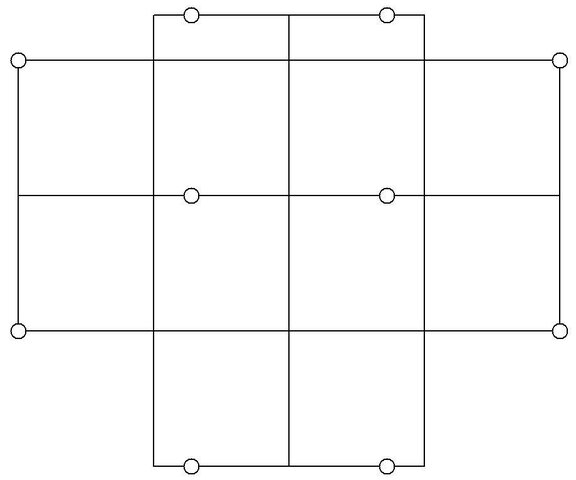So, a little background information first. I am a lighting designer at a community theatre. This theatre is unique as it is outdoors in a tent. The space is also set up in a ¾ round. Every show is a new challenge, but most I am able to work through. Except this one.
Our rigging system is set up like a grid. We use 1-1/2” aluminum triangle truss. The whole system is held with 10 – ¼ ton chain motors. I am not able to provide a better picture at this time, but here is how the grid is set up:

Each large segment is 15’, while the shorter segments are only 5’. No truss section is completely continuous. At each joint, there is a connector. I have roughly indicated the location of each motor. Unfortunately, the motors cannot be moved.
Recently, we upgraded our sound system, adding more weight to the grid with the new speakers. Also, we have been using moving lights for some of our shows. My biggest concern is obviously the load limits. With all of this heavy equipment, I am beginning to fear that the current setup will not hold.
I am just trying to determine how to calculate the loads at each pick point. I am an engineer, so the math is not a problem for me. My first approach at this particular problem involved my knowledge of statics, dynamics, and mechanics of materials. Would this be appropriate? Using moment and force diagrams? Or is there an easier way? This seems to be a complex problem since I am having trouble finding information freely available online. What I was originally looking for is a good book on rigging that went into detail the calculations for such a problem. Like I said, the math is not an issue for me, but I just need to know the calculations for the loads. Does anyone have any recommendations?
Our rigging system is set up like a grid. We use 1-1/2” aluminum triangle truss. The whole system is held with 10 – ¼ ton chain motors. I am not able to provide a better picture at this time, but here is how the grid is set up:

Each large segment is 15’, while the shorter segments are only 5’. No truss section is completely continuous. At each joint, there is a connector. I have roughly indicated the location of each motor. Unfortunately, the motors cannot be moved.
Recently, we upgraded our sound system, adding more weight to the grid with the new speakers. Also, we have been using moving lights for some of our shows. My biggest concern is obviously the load limits. With all of this heavy equipment, I am beginning to fear that the current setup will not hold.
I am just trying to determine how to calculate the loads at each pick point. I am an engineer, so the math is not a problem for me. My first approach at this particular problem involved my knowledge of statics, dynamics, and mechanics of materials. Would this be appropriate? Using moment and force diagrams? Or is there an easier way? This seems to be a complex problem since I am having trouble finding information freely available online. What I was originally looking for is a good book on rigging that went into detail the calculations for such a problem. Like I said, the math is not an issue for me, but I just need to know the calculations for the loads. Does anyone have any recommendations?


